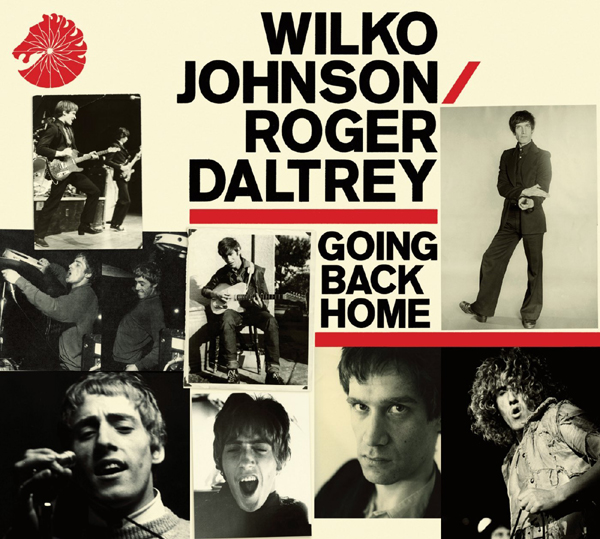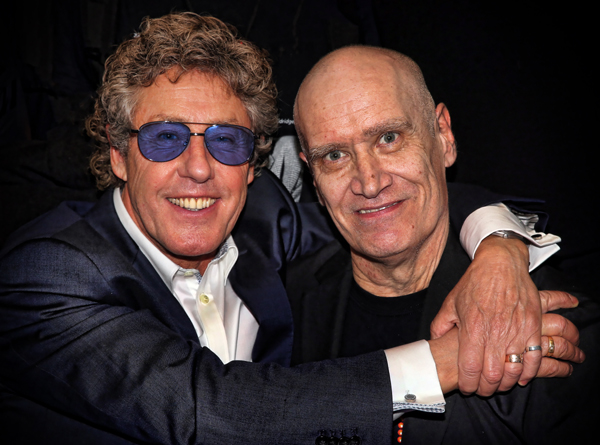Wilko Johnson: _Going Back Home_ with Roger Daltrey

The simple fact of the matter is Wilko Johnson isn’t supposed to be with us at this point – let alone playing slam-banging, foot-stomping rock ‘n’ roll with a new album that debuted at the number three spot on the U.K. album charts.
But the 66-year-old Johnson has never done things quite like anyone else.
From the first moment Johnson caught the public’s eye back in the early 70s with the British pub rockers Dr. Feelgood, his image has been as unique as his guitar playing. Mad-eyed and unblinking, lurching/darting/back-and-forthing about the stage, Johnson introduced the world to his own brand of rhythm/lead guitar. Bare-handed and wielding his picking arm like a crazed lumberjack, Johnson proved that one man and a black Telecaster could construct a wall of roaring chords, somehow firing off wailing leads in the midst of it like a sniper atop his perch.
You could attempt to look his style up, but there’s no point – Wilko wrote the book.
Fast-forward to January of 2013: diagnosed with metastatic pancreatic cancer, Johnson was told he would be dead by October – with the possibility of extending things a bit if he wanted to undergo chemotherapy. Johnson says the decision was an easy one: he declined any treatments, strapped on his Telecaster, and started playing as much rock ‘n’ roll as he had time for.
Besides live shows (“We did our ‘farewell tour’,” says Wilko with a laugh; “Now we just do tours.”), Johnson made the time to record a studio album. Going Back Home finds the guitarist joined by longtime wingmen Norman Watt-Roy (bass) and Dylan Howe (drums), along with veteran keyboardist Mick Talbot and blues harpman Steve Weston. And on vocals? Well, that would be another old-schooler: Roger Daltrey, whom you may know from his years with another band of ruffians, The Who.
10 of the 11 songs on Going Back Home are fresh takes on Wilko-penned classics. The title track kicks things off with a blast of slashing Telecaster and never looks back, with tunes ranging from the bluesy wail of “Keep On Loving You” and the hip-bump of “I Keep It To Myself” to the punk funk of “Keep On Loving You” and the album’s one “quiet” moment, the pensive “Turned 21”. Going Back Home’s lone cover is a powerful cover of Bob Dylan’s “Can You Please Crawl Out Your Window” – the entire band playing as if their very lives depended on it.
Of course, in a way …
Wilko Johnson has looked his illness in the eye with that same unblinking stare that he’s played a lifetime of music with. His bandmates on Going Back Home sound as if they’ve been energized with the same power that’s kept him going beyond the point that he was even expected to _live_ – let alone rock ‘n’ roll.
Going Back Home is not the work of a classic crooner doffing his top hat, singing “My Way” as the spotlight fades – this is Wilko Johnson saying “Goodbye” the same way he said “Hello” all those years ago: with Telecaster a’blazing.
Wilko was kind enough to share a few minutes of his precious time to talk a bit about Going Back Home, blood on the pickguard, the stars in the sky, and the amazing experience of the last year.
It should be noted that our conversation was postponed twice, due to Wilko feeling “wiped out,” according to his publicist in the UK. One of those postponements coincided with an Oxford Street record shop appearance in London; Roger Daltrey proved himself a true mate by stepping in for Johnson at the last moment. Wilko rallied in true punker form, however – performing songs off the new album with Daltrey and the lads at the Royal Albert Hall for the Teen Cancer Trust the evening before our interview. And the next day, he was on the phone: full of piss, vinegar, humor, reflection, and grace.
Fifteen minutes isn’t much, but neither is a few extra months at the end of a lifetime. If there’s one lesson to learn from Wilko Johnson, it’s make the most of it … so we did.
Wilko, first of all, I want to apologize. There’s something fundamentally wrong with you receiving this great gift of time … and then spending it talking on the phone.
Ha! Thank you!
The folks who gave you the diagnosis over a year ago … do you ever call them to see how they’re feeling these days?
Well … (laughs) I was supposed to have been dead in October, you know, and that went by. And I thought, “Maybe I ought to go in for another estimate …”
But I don’t think I’ll bother. I’m not having any treatment, you know, and I’m still feeling okay. I’ve just got this lump in my stomach that continues to grow – other than that, I’m just fine!
Well, blessings on you. You realize, of course, that a lot of folks might’ve gone another route with this album under the same conditions. There’s certainly nothing maudlin or sad about Going Back Home : it’s more of a celebration than anything.
Oh, absolutely. I mean, this album looked like it was going to be the last thing I’d ever do … which gave me the opportunity to work with Roger Daltrey! (laughs)
And we said, “What are going to do?”
“We’re going to rock ‘n’ roll, of course!”
I guess the softest moment on the album is “Turned 21”, which is a sweet song, but it’s not a downer by any means.
No, no – more … umm … poignant! (laughs)
How did you choose these particular songs?
The idea originally came up a couple of years ago, actually – the initial conversation with Roger. At that time I thought I wanted to do something a bit “up” – I was thinking about covers of 60s American soul music and so forth … there was a lot of good stuff back then.
When it came down to it last year, I said, “Well, if it’s going to be the last thing I do, I’ll just take the opportunity to do a bit of a retrospective of my own records.” So Roger picked some that he thought he could do something with. We had to do the thing very quickly – we had eight days to make this record. There was no time for any … finesse, I guess you’d say. (laughs)
That’s part of the beauty of it, though: it has this neat looking-each-other-in-the-eye vibe to it.
Exactly! Everything was played live in the studio, with us looking at each other … pulling faces and whatnot. We had a tremendous time doing it, working very fast.

Photo by Anthony D’Angio
I’m not aware of you and Roger having recorded before – had you ever even shared a stage?
No – never. We just kind of had a nodding acquaintance over the years. We’ve really met for the first time, coming together to do this album.
But listening to this album, it sounds like you’ve been doing it together for years. Of course, Norman Watt-Roy on bass and Dylan Howe on drums were natural choices but how about keyboardist Mick Talbot – had you worked together before?
No, we hadn’t. He’d played with Paul Weller … and I think Dexy’s Midnight Runners. And then the harmonica player, Steve Weston, is a guy from my town and we thought we’d bring him in. Everybody got along really well. It was an incredible experience.
Now when I hear this music, in my mind’s eye I see you brandishing your legendary black Telecaster with the red pickguard. Is that what you used for these sessions?
Well, you see…finally, after 35 years, Fender gave me the accolade of building an official Wilko Johnson Telecaster – it came out last year. I think they only made about five of ‘em (laughs) and they’re all sold out.
And on the album you used…
That’s the thing: I still have all the Telecasters I’ve ever owned – four, I think – but in the last year I’ve been playing my official Wilko Johnson Telecaster … ‘cause I’m so proud of it! (laughter)
Your right hand has always taken a beating over the years from your very aggressive playing style – with no pick. I’ve always thought, “Man – there have to be some serious callouses and scars there. Have you made any concessions of late – taking it a bit easier on yourself perhaps – with lighter-gauge strings or anything?
Oh, no … I really just kind of bash away, you know? It’s very crude what I do. And sometimes you bleed. (laughter)
Well, I guess if one really means it, they’re going to draw blood one way or the other.
Yes, I imagine so. That’s what I’ve always told people about the red scratch plate, you know: “You can’t see the blood.” (laughter)
Wilko, I know you’re not doing this to set an example or make a statement … but you have to be aware that your decision has inspired people over the last year.
Oh, yes. People have written to me – or they’ve come up to me on the street and spoke about finding strength in some of the things I’ve said. It’s quite moving … I mean … all I’m doing is carrying on, you know?
I know, and you’re doing it because that’s the way you’ve decided to do it and that’s that.
Well, yes. Instead of being out and doing rock ‘n’ roll, a person could be sitting at home getting profound and philosophical, I guess.
I’ve read that you have a passion for astronomy. I suppose when you look up into the heavens, it’s a bit like a mechanic looking under the hood … But I wanted to ask you if you ever think about what comes next when you’re looking up at the night sky?
Well … like last year when I thought I had just a few months, I sort of said goodbye to Saturn as that moved out of the sky … said goodbye to the constellation Orion. You know, “Well, goodbye, then – I’ll never see you again.”
And since then, Orion’s come back and so has Saturn … I really didn’t think I’d see these things again and there they are – and here I am.
But what comes next? No … who knows? One can speculate ad infinitum, right?
I know you lost your wife Irene – your childhood sweetheart – to cancer in 2004. Do you think if she were still here today, you’d have made a different decision as far as your own cancer?
Oh, no – I would’ve made the same decision. It really wasn’t a difficult one, you see: they told me they couldn’t cure the cancer; they couldn’t stop it – all they could do was slow it down.
“You’ve probably got about 10 months to live – maybe a year, if you have chemotherapy.” (laughs) That didn’t sound like a very good deal to me. I’d rather let the cancer take its course, you know? I know what it’s like to have someone I loved taken away from me … that’s the most painful thing I could ever go through.
When my wife died, it was much quicker; she died within four months of the diagnosis.
But this past year has been so extraordinary – all the things that have happened to me. I’ve really had some marvelous experiences.
I hear you. I could ask you about your plans, but if I’ve learned anything from talking to you, it’s “be here right now.”
Yes! (laughs) That’s about the size of it.
*****
Brian Robbins works hard to “be here right now” over at www.brian-robbins.com



















